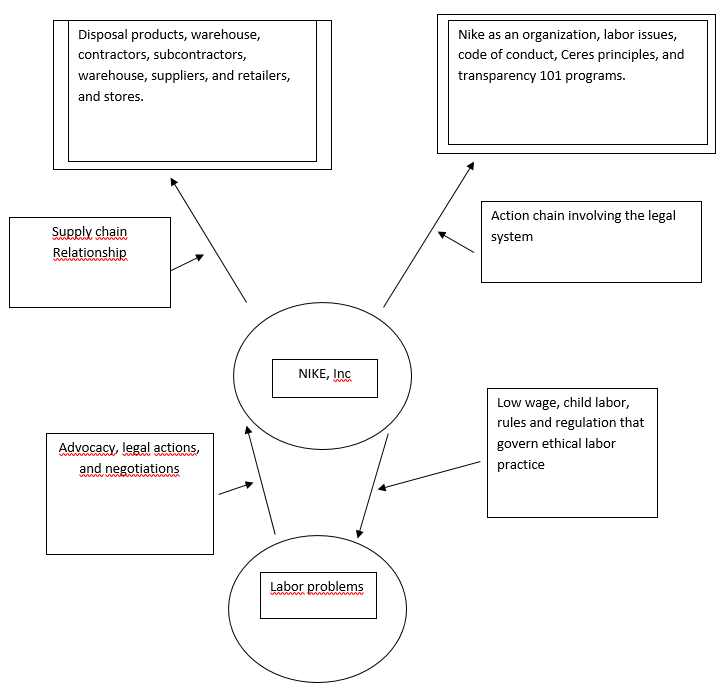
Mind map for NIKE Problems
Nike has been facing labor problems since its conception in 1964. The major labor problems are child labor and low wages that it offers to its employees in third world countries. There are concrete interrelations in Supply chain relationships and action chain. These relationships have either positive or negative effects on the labor problems affecting the company
Supply chain relationship
This relationship involves both external and internal elements of the company. The internal elements are contractors, subcontractors, suppliers of raw materials, and raw materials outsourcing. On the other hand, external elements are product disposal, retailers, customers, warehouses, and store companies.
- Suppliers of Raw Materials: They offer the basic ingredients to the manufacturing of the final products. These local suppliers of raw materials are contracted by NIKE Company in their respective countries. Enhanced supply chain management promotes a constant flow of raw materials which in turn increases revenue thus high wages for employees (Ballinger, 2001).
- Raw Materials Outsourcing: Some raw materials are supplied by contractors and subcontractors. They are supplied from outside home countries.
- Contractors: These are ion charge of the production of the products of the company. Principally, their role is to collect raw materials from the suppliers and the production of the company’s products basing on the agreement between them and the organization. Most of these contractors are from countries like Korea, Japan, Indonesia, China, and Vietnam. Nike’s labor problem is rampant in these countries and many reports show that these contractors use cheap labor and in some instances, they use the service of underage labor (Ballinger, 2001).
- Subcontractors: These are in charge of the production of NIKE products on behalf of contractors and so they negatively contribute to the labor problems faced by NIKE when they employ unacceptable labor practices such as the use of child labor and underage labor (Mitzberg, 2009).
- Warehouse: Products produced by NIKE, its contractors, and subcontractors are delivered in warehouses for distribution to other chains of distribution.
- Retailers and stores of NIKE: NIKE products from warehouses are received by retailers and stores for distribution to consumers.
- End-users: These are the consumers of the products and are attracted if the products are of high quality. The consumer requires a high ethical standard by the company and in many cases, they boycott products of the organization that does not adhere to best practices such as reasonable wages to employees (Mitzberg, 2009).
- Disposal products: NIKE produces a large number of disposal products that require effective disposal. To avoid pollution, these products should be disposed of safely to avoid hazards to both the employees and the general public. Third world countries have faced risky disposal procedures that have affected the environment of the community near the location of the company or its contractors (Ballinger, 2001).
Action chain involving the legal system
This is a legal system that entails the establishment of efficient and effective codes of conduct and ethics between NIKE, manufacturers, consumers, labor force, and governments. It may involve an appropriate response to employment, environment, and social factors that production of the company and its relationship with other stakeholders. CERES principles are endorsed to ensure that Nike publicly reveals its performance. Furthermore, the creation of the Transparency 101 program may enable Nike to cope with issues related to labor, and report their performance to the relevant communities.
- Nike: This is the main component that offers the strategic, technical, and regulatory directions to its employees and contractors and subcontractors about the manufacture of its products. It ensures quality, ethical, and timely production to satisfy the needs of the consumers. Problems that have arisen from labor practices can be attributed to NIKES’ inaction against the violation of labor rules by its branches, contractors, and subcontractors. Nike has an established code of conduct to ensure its contractors operate by their working conditions and respect human rights. Moreover, Nike is also able to respond to labor issues affecting their manufacturers through effective implementation of the Transparency 101 program and CERES Principles.
- Code of conduct: Conduct of conduct is an agreement that Nike establishes between manufacturers and the company. It ensures that the manufacturers’ activities do not pollute the environment, and protects the rights of human beings in the working environment (Ballinger, 2001).
- Labor problems: There are several labor issues that Nike faces from its manufacturers, branches, and contractors and it has to effectively and adequately respond to them to ensure good working relations. The major labor issues are under the payment of workers and employing the services of child labor (Mitzberg, 2009).
- CERES Principles: Basically, CERES is a ten-point code embraced by corporate to regulate the environmental conduct of corporate. This policy is universally endorsed by several companies to effectively respond to environmental issues and enhance accountability. Nike embraced this theory to improve its work on social and environmental issues (CERES Principles, 2009).
- Transparency 101 program: Endorsement of the CERES principles requires Nike to openly discuss their performance with interest groups and the public. Therefore, the establishment of Transparency 101 might enable Nike to effectively monitor its manufacturers and ensure that they follow Nike’s code of conduct hence minimizing labor issues (CERES Principles, 2009).
References
Ballinger, J. (2001). “Nike’s Voice Looms Large”. Social Policy 4 (6): 33-39.
CERES Principles. (2009). CERES Principles. Web.
Mitzberg, G. (2009). CERES Principles. Indiana: Pearson Education.
Nike. (2012). About Nike. Oxford: Oxford University Press.